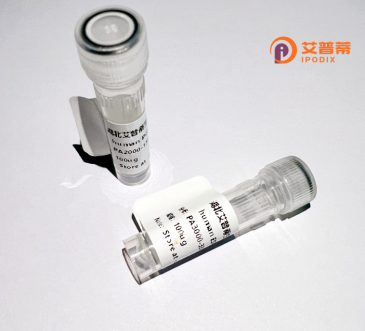
| 纯度 | >90%SDS-PAGE. |
| 种属 | Human |
| 靶点 | CUL4B |
| Uniprot No | Q13620 |
| 内毒素 | < 0.01EU/μg |
| 表达宿主 | E.coli |
| 表达区间 | 1-913aa |
| 氨基酸序列 | MMSQSSGSGDGNDDEATTSKDGGFSSPSPSAAAAAQEVRSATDGNTSTTPPTSAKKRKLNSSSSSSSNSSNEREDFDSTSSSSSTPPLQPRDSASPSTSSFCLGVSVAASSHVPIQKKLRFEDTLEFVGFDAKMAEESSSSSSSSSPTAATSQQQQLKNKSILISSVASVHHANGLAKSSTTVSSFANSKPGSAKKLVIKNFKDKPKLPENYTDETWQKLKEAVEAIQNSTSIKYNLEELYQAVENLCSYKISANLYKQLRQICEDHIKAQIHQFREDSLDSVLFLKKIDRCWQNHCRQMIMIRSIFLFLDRTYVLQNSMLPSIWDMGLELFRAHIISDQKVQNKTIDGILLLIERERNGEAIDRSLLRSLLSMLSDLQIYQDSFEQRFLEETNRLYAAEGQKLMQEREVPEYLHHVNKRLEEEADRLITYLDQTTQKSLIATVEKQLLGEHLTAILQKGLNNLLDENRIQDLSLLYQLFSRVRGGVQVLLQQWIEYIKAFGSTIVINPEKDKTMVQELLDFKDKVDHIIDICFLKNEKFINAMKEAFETFINKRPNKPAELIAKYVDSKLRAGNKEATDEELEKMLDKIMIIFRFIYGKDVFEAFYKKDLAKRLLVGKSASVDAEKSMLSKLKHECGAAFTSKLEGMFKDMELSKDIMIQFKQYMQNQNVPGNIELTVNILTMGYWPTYVPMEVHLPPEMVKLQEIFKTFYLGKHSGRKLQWQSTIGHCVLKAEFKEGKKELQVSLFQTLVLLMFNEGEEFSLEEIKQATGIEDGELRRTLQSLACGKARVLAKNPKGKDIEDGDKFICNDDFKHKLFRIKINQIQMKETVEEQASTTERVFQDRQYQIDAAIVRIMKMRKTLSHNLLVSEVYNQLKFPVKPADLKKRIESLIDRDYMERDKENPNQYNYIA |
| 分子量 | 130.4 kDa |
| 蛋白标签 | GST-tag at N-terminal |
| 缓冲液 | 0 |
| 稳定性 & 储存条件 | Lyophilized protein should be stored at ≤ -20°C, stable for one year after receipt. Reconstituted protein solution can be stored at 2-8°C for 2-7 days. Aliquots of reconstituted samples are stable at ≤ -20°C for 3 months. |
| 复溶 | Always centrifuge tubes before opening.Do not mix by vortex or pipetting. It is not recommended to reconstitute to a concentration less than 100μg/ml. Dissolve the lyophilized protein in distilled water. Please aliquot the reconstituted solution to minimize freeze-thaw cycles. |
以下是3篇关于重组人CUL4B蛋白的相关文献摘要信息:
---
### 1. **"CUL4B ubiquitin ligase in DNA damage response and cancer"**
*作者:Wang, Y., et al.*
**摘要**:本文通过重组表达人CUL4B蛋白,揭示了其与DDB1组成的CRL4B泛素连接酶复合体在DNA损伤修复中的作用。研究显示,重组CUL4B通过调控组蛋白H2A的泛素化影响染色质重塑,并可能参与肿瘤发生。
### 2. **"Structural insights into the assembly of the CRL4B ubiquitin ligase complex"**
*作者:Li, T., & Zheng, N.*
**摘要**:作者利用大肠杆菌表达系统制备了重组人CUL4B蛋白片段,结合冷冻电镜技术解析了CRL4B复合体的三维结构,阐明CUL4B与DDB1、ROC1等蛋白的相互作用界面,为靶向该复合体的药物设计提供了结构基础。
### 3. **"Functional analysis of CUL4B mutations in X-linked intellectual disability"**
*作者:Hu, H., et al.*
**摘要**:本研究通过表达重组突变型CUL4B蛋白,发现其泛素连接酶活性显著降低,导致下游底物(如组蛋白甲基转移酶)异常积累,揭示了CUL4B基因突变引发神经发育障碍的分子机制。
---
**备注**:若需具体文献来源或更多信息,建议通过PubMed或Google Scholar检索上述关键词,或结合实验目的缩小范围(如靶向疾病、相互作用蛋白等)。部分研究可能未直接使用重组CUL4B蛋白,但涉及其在泛素化通路的功能机制。
Cullin 4B (CUL4B) is a member of the cullin protein family, which serves as a scaffold for the CRL4B (Cullin-RING ligase 4B) E3 ubiquitin ligase complex. This complex plays a central role in the ubiquitin-proteasome system by tagging specific substrate proteins with ubiquitin, marking them for proteasomal degradation. CUL4B functions in diverse cellular processes, including DNA damage repair, chromatin remodeling, cell cycle regulation, and epigenetic modulation. Structurally, it interacts with adaptor proteins (e.g., DDB1) and substrate receptors to recruit targets such as histone-modifying enzymes or tumor suppressors. Mutations or dysregulation of CUL4B are linked to neurodevelopmental disorders (e.g., X-linked intellectual disability) and cancers, where its aberrant activity may promote oncogenesis by destabilizing tumor suppressors.
Recombinant human CUL4B protein is engineered in vitro using expression systems like Escherichia coli, insect cells, or mammalian cells. This technology enables large-scale production of functional CUL4B for mechanistic studies, such as mapping protein interactions, elucidating post-translational modifications, or screening inhibitors. Its recombinant form is critical for studying CRL4B’s role in disease pathways and developing targeted therapies. For example, inhibitors targeting CUL4B-associated ligase activity are being explored as potential anticancer agents. Research on recombinant CUL4B continues to uncover its regulatory complexity and therapeutic potential in precision medicine.
×